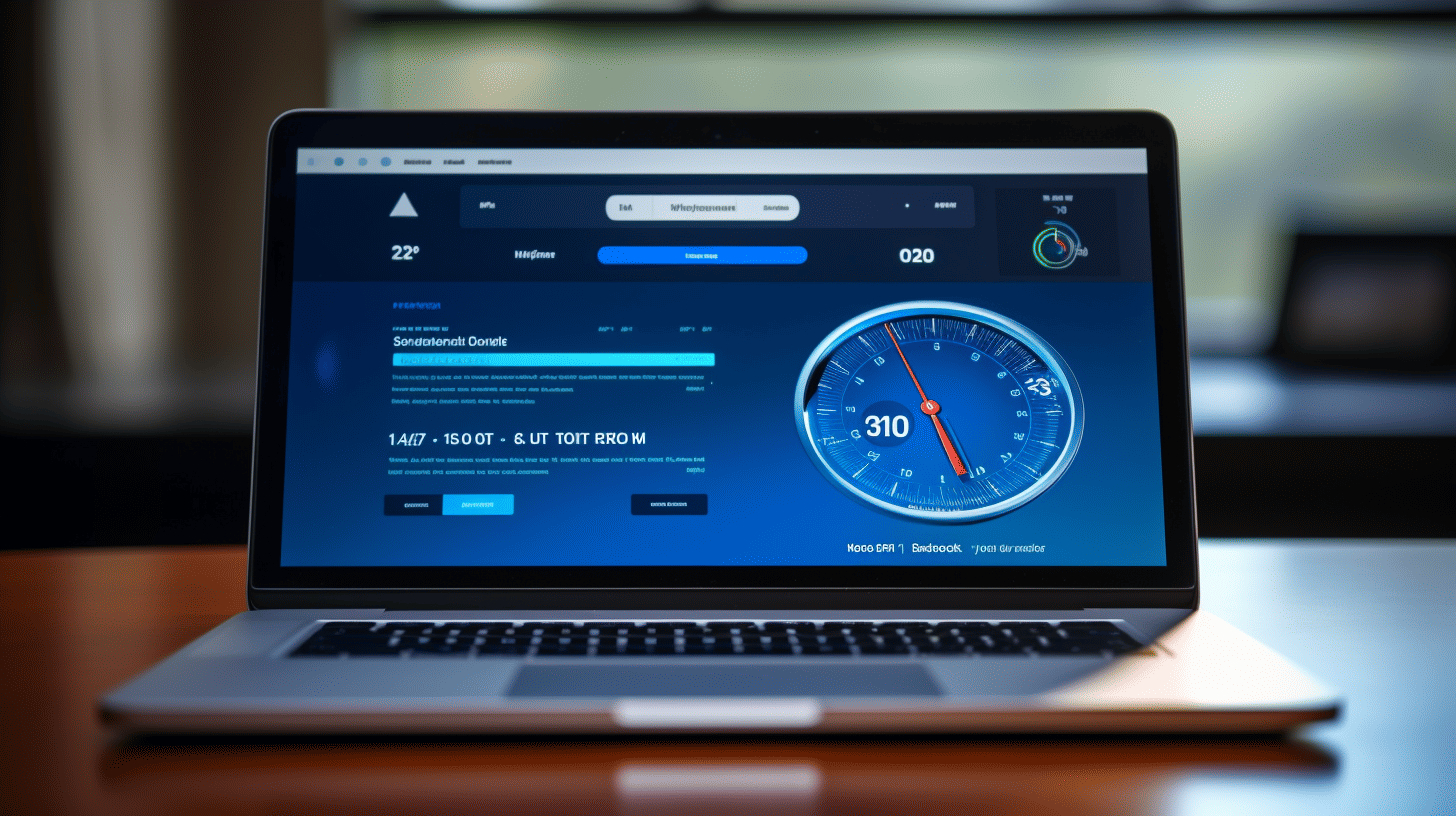In today’s fast-paced digital world, every second counts. Users expect websites to load quickly and seamlessly. Slow-loading websites can be frustrating for visitors and lead to a negative user experience. Research shows that website speed plays a critical role in user satisfaction and can impact important metrics such as conversion rates and bounce rates.
For WordPress websites, optimizing speed is crucial for delivering a smooth and efficient experience to users. Slow-loading WordPress sites can hinder your online presence and negatively affect your business outcomes. However, the good news is that there are proven techniques and strategies to accelerate WordPress websites and enhance their performance.
In this article, we will explore the importance of website speed, the impact of loading time on key metrics, and delve into specific techniques to speed up WordPress websites. Whether you’re a business owner, developer, or a WordPress enthusiast, this article will provide valuable insights and actionable tips to help you unlock the full potential of your WordPress website.
So, fasten your seatbelts as we embark on a journey to unlock the speed and optimize the performance of your WordPress website!
The Importance of Website Speed
When it comes to running a successful website, there’s one crucial factor that can make or break your online presence: website speed. In today’s fast-paced digital world, users have become increasingly impatient, expecting websites to load instantly. If your site takes too long to load, you risk losing potential customers and harming your conversion rates. But just how important is website speed, and what impact does it have on user experience and conversion rates? Let’s dive in and explore.
Average Website Load Time
According to recent data, the average website load time in 2023 is approximately 2.5 seconds on desktop and a slightly longer 8.6 seconds on mobile devices. These numbers may seem relatively short, but when it comes to website load times, every second counts. Research has shown that even a one-second delay in page load time can result in a significant drop in customer satisfaction and engagement.
Conversion Rates and Loading Speed
Website speed doesn’t just affect user experience, it also has a direct impact on your conversion rates. Studies have revealed that websites with faster load times, around one second, experience a conversion rate of 39%. On the other hand, sites with slower load times have lower conversion rates. This shows that users are more likely to abandon a website if it takes too long to load, resulting in missed opportunities for conversions and potential revenue loss.
User Expectations for Loading Speed
In addition to the impact on conversion rates, website speed is also important because it directly affects user expectations. As technology continues to advance, users have become accustomed to faster and more efficient online experiences. According to statistics, a staggering 64% of smartphone users expect a web page to load in four seconds or less. Anything beyond that, and you risk frustrating your visitors and driving them away.
To ensure that your website meets these expectations and delivers an optimal user experience, it’s crucial to prioritize website speed optimization. By taking steps to reduce page load times, you can enhance user satisfaction, boost your conversion rates, and ultimately, improve your overall online success.
Ready to turbocharge your website’s loading speed? Check out our comprehensive guide on Accelerating Website Loading Speed to learn effective strategies and techniques for optimizing your website’s performance.
The Impact of Website Loading Time
In today’s fast-paced digital world, where instant gratification is the norm, website loading time plays a crucial role in determining the success or failure of a website. A slow-loading website can result in frustrated users, lower conversion rates, and potential customers bouncing off to competitors’ sites. On the other hand, a fast-loading website can enhance the overall user experience, boost engagement, and increase the likelihood of a user making a purchase or taking a desired action.
⚡ Performance and Conversion Rates
One of the key factors affected by website loading time is conversion rates. Studies have shown that even a small delay in page load time can have a significant impact on conversion rates. According to industry research, for every extra second it takes for a website to load, conversion rates drop by an average of 4.42% within the first five seconds[1]. This means that for an e-commerce website generating $100,000 in revenue per day, a one-second delay in loading time can potentially cost the business $2.5 million in lost sales annually[1].
⚡ Bounce Rate and Page Speed
Website loading time also has a direct correlation with bounce rate – the percentage of visitors who navigate away from a website after viewing only one page. Research suggests that a one-second delay in website load time can increase the probability of bounce by a staggering 32%[1]. This implies that if your website takes too long to load, users are more likely to abandon it before even exploring its content or offerings. First impressions matter, and slow loading times can drive potential customers right into the welcoming arms of your competitors.
⚡ Page Speed and Purchase Decisions
Not only does website loading time impact bounce rates and conversion rates, but it also influences customers’ purchase decisions. A study revealed that nearly 70% of consumers admit that page speed affects their willingness to make a purchase on a website[1]. If your website takes ages to load, potential customers may choose to leave, wary of the notion that if a website cannot load quickly, it may not provide a smooth and reliable shopping experience. In today’s competitive online marketplace, where countless options are a click away, providing a fast and seamless browsing experience is crucial in gaining the trust and confidence of consumers.
Improving website loading time should be a top priority for businesses looking to succeed in the digital landscape. By optimizing website performance and reducing loading times, you can enhance user experience, increase engagement, and drive higher conversion rates. In the next sections, we will explore actionable strategies and best practices to improve website loading time, providing you with the knowledge you need to boost your website’s performance and leave a lasting impression on your visitors. Stay tuned!
Did you know? A one-second delay in website load time can increase the probability of bounce by 32%[1].
[1]: Source: Kissmetrics
Proven Techniques for Speeding Up WordPress Websites
In today’s fast-paced world, website speed is crucial for success. Slow-loading websites not only frustrate users but also lower search engine rankings. As a WordPress website owner, you need to ensure that your site is optimized for speed to provide a seamless browsing experience for your visitors.
Here are some proven techniques to speed up WordPress websites that will help you enhance performance, engage users, and boost your SEO rankings.
Image Optimization
One of the main culprits slowing down WordPress websites is large, unoptimized images. High-resolution images can significantly affect page load times, especially for users on slower internet connections or mobile devices.
Image optimization is a must for faster website loading times. By compressing and resizing images without sacrificing quality, you can reduce the file size while still maintaining the visual appeal of your website.
Consider implementing these image optimization techniques:
- Use appropriate image dimensions: Resize images to fit the exact dimensions required on your web pages. This prevents the browser from wasting resources resizing them on the fly.
- Compress images: Reduce the file size of your images without compromising quality using image compression tools or WordPress plugins like Smush.
- Leverage lazy loading: Lazy loading delays the loading of images until they are about to be viewed by the user, reducing the initial page load time.
Enabling Caching
Caching is a technique that helps store a static version of your website, allowing subsequent page loads to be served more quickly. By enabling caching, you can reduce server response time and minimize the amount of data that needs to be transmitted, leading to faster page load times.
Here are a few caching methods you can implement:
- Browser caching: Instruct visitors’ browsers to store static resources like CSS, JavaScript, and images, so they don’t need to be reloaded on subsequent visits.
- Server-side caching: Utilize server-side cache mechanisms such as Memcached or Redis to store generated HTML pages and reduce the processing time required for each request.
- WordPress caching plugins: Use popular plugins like W3 Total Cache or WP Super Cache to easily enable caching on your WordPress site.
Minifying CSS and JavaScript
Excessive CSS and JavaScript files can slow down your website by increasing the number of requests made to the server. Minifying these files involves removing unnecessary characters, like white spaces and comments, as well as combining multiple files into one, reducing the total file size.
By minifying CSS and JavaScript, you’ll benefit from:
- Faster download times: Reduced file sizes mean faster downloads for your website’s visitors.
- Fewer HTTP requests: Combining multiple CSS and JavaScript files into one reduces the number of requests made to the server.
Using a Content Delivery Network (CDN)
A Content Delivery Network (CDN) is a global network of servers distributed geographically. By caching your website’s static assets on these servers, a CDN delivers content from the server closest to the user, reducing the distance data needs to travel and improving website performance.
Implementing a CDN offers several advantages:
- Reduced latency: Content is delivered from the nearest server, minimizing the time it takes to load your website.
- Improved scalability: By offloading your static content to a CDN, your server can handle more requests, improving overall scalability.
- Enhanced security: CDNs often provide additional layers of security, such as DDoS protection and web application firewalls.
Font Optimization
Fonts play a significant role in the overall design and aesthetics of your website. However, using too many or large font files can slow down your WordPress website. Font optimization is essential for enhancing website speed without compromising the visual appeal.
Consider the following font optimization techniques:
- Limit font usage: Stick to a select few fonts and avoid using numerous font styles on a single page.
- Use web-safe fonts: Web-safe fonts are pre-installed on most devices, reducing the need to load additional font files.
- Load fonts asynchronously: By loading font files asynchronously, your website won’t be blocked from rendering while waiting for the fonts to load.
Optimizing images, enabling caching, minifying CSS and JavaScript, using a Content Delivery Network (CDN), and font optimization are just a few effective techniques to speed up your WordPress website. By implementing these strategies, you’ll provide a better user experience, improve your SEO rankings, and increase visitor engagement.
To learn more about supercharging your WordPress website’s performance, check out this comprehensive guide on Supercharging WordPress Websites Performance.
WordPress Specific Speed Improvements
Is your WordPress website taking ages to load? Don’t worry, we’ve got your back! In this article, we’ll explore some specific speed improvements you can make to your WordPress site. By implementing these strategies, you’ll ensure a fast-loading site that keeps your visitors engaged and satisfied.
Choosing the Right Hosting
When it comes to website speed, choosing the right hosting provider is crucial. Here are some key factors to consider when selecting a hosting service for your WordPress site:
- Performance: Look for a hosting provider that offers high-performance servers optimized for WordPress. This ensures your site will load quickly and efficiently.
- Reliability: Opt for a reliable hosting service that guarantees minimal downtime. After all, what good is a fast site if it’s frequently inaccessible?
- Scalability: As your site grows, you’ll want a hosting provider that can accommodate increased traffic without sacrificing performance. Make sure they offer scalable hosting plans that can handle your future needs.
- Security: A secure hosting environment is vital for protecting your website from cyber threats. Choose a provider that offers robust security measures, such as firewalls, SSL certificates, and regular backups.
By choosing the right hosting provider, you’ll lay a solid foundation for a lightning-fast WordPress site.
Using Caching Plugins
Caching plugins are a game-changer when it comes to speeding up your WordPress site. These plugins generate static HTML files and serve them to visitors, bypassing the need to generate dynamic content for every page request. Here’s why you should consider using a caching plugin:
- Faster Page Load Times: By caching static HTML files, your site will load significantly faster for both new and returning visitors.
- Improved Server Performance: Caching reduces the server’s workload by serving cached files instead of processing resource-intensive PHP scripts and database queries.
- Better User Experience: A speedy site pleases visitors and keeps them engaged. They’re more likely to stay longer, browse more pages, and convert into loyal customers.
There are several excellent caching plugins available for WordPress. Some popular options include WP Rocket, W3 Total Cache, and WP Super Cache. Take your time to explore these plugins and choose the one that best fits your website’s needs.
Database Optimization
WordPress uses a database to store all your website’s content, such as posts, pages, and settings. Over time, this database can become bloated with unnecessary data, slowing down your site. Here’s how you can optimize your WordPress database for maximum speed:
- Remove Unnecessary Plugins and Themes: Deactivate and delete any unused plugins and themes from your WordPress installation. They take up space in your database and can slow down your site.
- Clean Up Your Database: Use a plugin like WP-Optimize or WP-Sweep to remove unnecessary data such as post revisions, spam comments, and transients. These plugins can also optimize your database tables for better performance.
- Optimize Images: Large image files can significantly slow down your site. Use an image optimization plugin like Smush or EWWW Image Optimizer to compress and resize your images without losing quality.
Implementing these database optimization techniques will help streamline your WordPress site and improve its overall speed and performance.
Remember, good web hosting, caching plugins, and database optimization are essential for improving WordPress site speed. By following these tips, you’ll be well on your way to delivering a lightning-fast website experience to your visitors.
So, why wait? Start implementing these speed improvements today and watch your WordPress site soar to new heights of performance and user satisfaction! 🚀
Demystifying WordPress Cloud Hosting
Conclusion
In conclusion, improving the speed of your WordPress website is crucial for a successful online presence. The impact of website loading time on various aspects such as conversion rates, bounce rate, and user expectations cannot be overlooked. By implementing proven techniques like image optimization, enabling caching, minifying CSS and JavaScript, using a CDN, and font optimization, you can significantly enhance the speed and performance of your WordPress site.
Specific WordPress speed improvements such as choosing the right hosting, utilizing caching plugins, and optimizing your database can further contribute to a faster and more efficient website.
Managed-WP is a premium managed WordPress cloud hosting platform that can help streamline your website infrastructure and ensure optimal speed and performance. With their expertise in problem-solving and 24/7/365 support, Managed-WP is the perfect partner to enhance your WordPress website’s speed and overall functionality.
Start unlocking the full potential of your WordPress website today with Managed-WP. Visit their website at managed-wp.com to explore their services and take your digital experiences to new heights.
Frequently Asked Questions
- What are some proven techniques for accelerating WordPress websites?
Some proven techniques for accelerating WordPress websites include: optimizing images, using caching plugins, minifying and combining CSS and JS files, utilizing a content delivery network (CDN), enabling GZIP compression, and choosing a fast and reliable hosting provider.
- Why is website speed important for a WordPress site?
Website speed is important for a WordPress site because it directly impacts user experience, search engine rankings, and conversion rates. A slow-loading website can lead to higher bounce rates and deter visitors from engaging with your content or making a purchase.
- How can I optimize images on my WordPress site for better performance?
To optimize images on your WordPress site, you can resize images to the appropriate dimensions, compress them without significant loss of quality using tools like Photoshop or plugins, and leverage lazy loading to load images only when they are visible to the user.
- What are caching plugins and how do they help in speeding up WordPress websites?
Caching plugins create static HTML versions of your dynamic WordPress pages and serve them to visitors, reducing the need to generate pages from scratch with each request. This helps in speeding up website loading times and reducing server load.
- Do I need technical skills to implement website speed optimization techniques in WordPress?
While some website speed optimization techniques might require technical skills, many can be implemented using plugins and user-friendly tools. However, it is recommended to have basic knowledge of WordPress and website optimization to ensure proper implementation and troubleshooting.



















